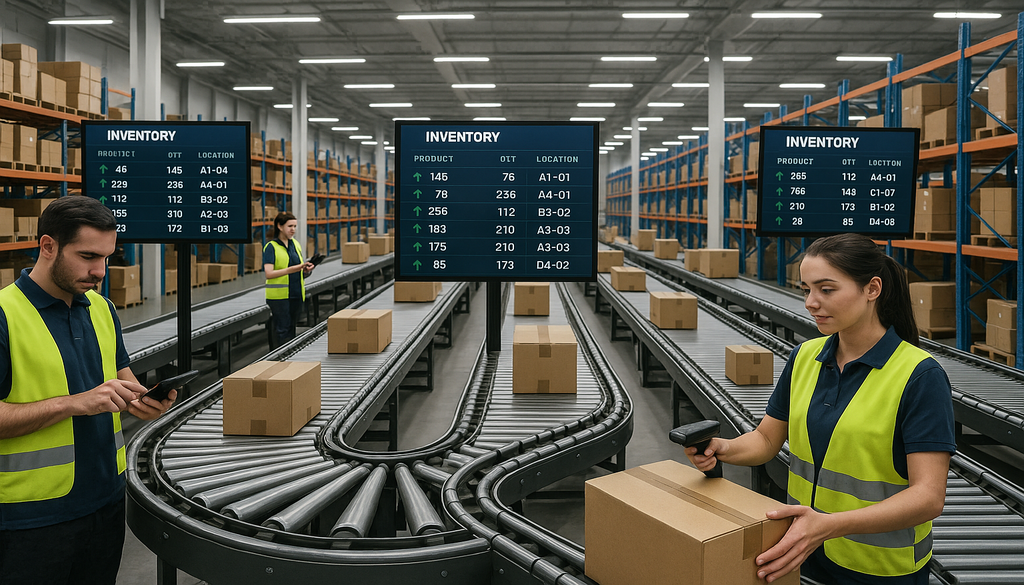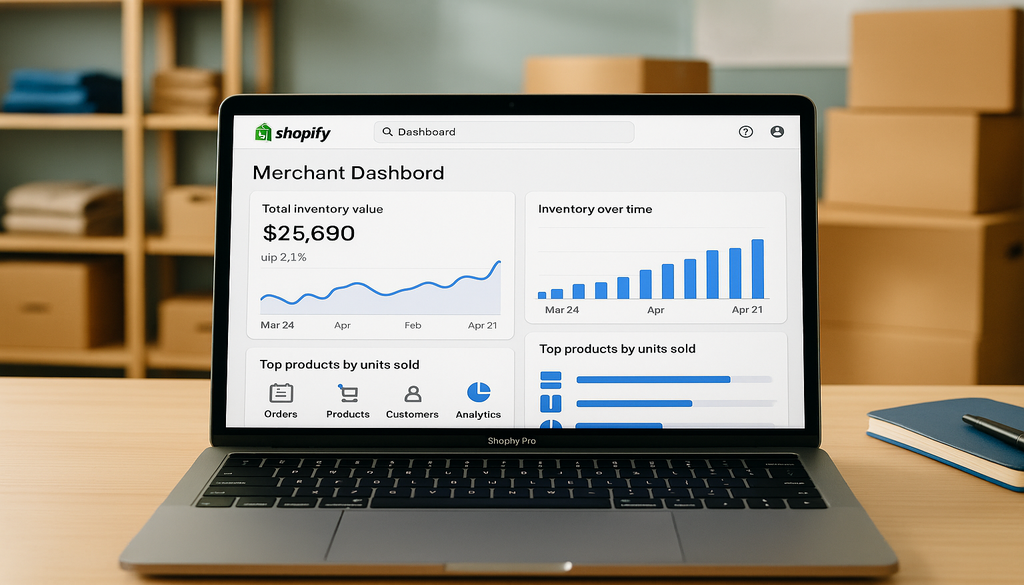In today’s rapidly evolving retail landscape, effective inventory management has become a cornerstone of successful ecommerce operations. The ability to track, manage, and optimize inventory across multiple sales channels isn’t just convenient—it’s essential for businesses seeking to maintain their competitive edge. Inventory management systems have emerged as powerful solutions that integrate various business processes, with inventory management being a critical component. Leading ecommerce platforms like Shopify, Amazon, and the emerging TikTok Shop each offer distinct approaches to inventory management, catering to different business needs and scales. Understanding the unique features, advantages, and limitations of each platform can help retailers make informed decisions that align with their operational requirements and growth strategies.
Understanding Inventory Management Systems in Ecommerce
The importance of effective inventory management in ecommerce cannot be overstated. In an environment where customers expect quick delivery and accurate product availability information, mismanaged inventory can lead to lost sales, damaged reputation, and increased operational costs. According to recent industry research, retailers with advanced inventory management systems report up to 30% fewer stockouts, 25% reduction in carrying costs, and 20% improvement in order fulfillment accuracy. These improvements directly translate to enhanced customer satisfaction and increased revenue. Furthermore, as ecommerce continues to grow at an unprecedented rate—accelerated by global shifts in consumer behavior—retailers face mounting pressure to streamline their inventory processes to remain competitive and agile in responding to market changes.
The integration of artificial intelligence and machine learning into inventory management systems has further revolutionized how retailers approach inventory planning. These technologies enable more accurate demand forecasting, dynamic pricing strategies, and automated inventory optimization. For instance, AI-powered systems can analyze historical sales data, seasonal trends, and external factors such as weather patterns or social media sentiment to predict future demand with remarkable accuracy. This predictive capability allows retailers to maintain optimal inventory levels, reducing both the risk of stockouts during peak demand periods and the financial burden of excess inventory during slower periods. As we examine the specific inventory management offerings from Shopify, Amazon, and TikTok Shop, it’s important to consider how each platform leverages these technologies to provide value to ecommerce retailers.
Shopify’s Inventory Management Features for Ecommerce Retailers
Shopify has established itself as a leading ecommerce platform for businesses of all sizes, offering a comprehensive suite of inventory management tools designed to enhance operational efficiency. At its core, Shopify’s inventory management system provides merchants with the ability to track stock levels across multiple locations, set up automated alerts for low inventory, and generate detailed inventory reports. The platform’s inventory management capabilities extend beyond basic tracking to include features such as inventory adjustments, transfers between locations, and batch inventory updates through CSV imports. These functionalities create a flexible foundation that can scale with growing businesses, making Shopify particularly attractive for small to medium-sized retailers who need robust inventory solutions without enterprise-level complexity.
One of Shopify’s key strengths lies in its extensive app ecosystem, which allows merchants to enhance the platform’s native inventory management capabilities. Apps like Stocky, developed by Shopify, provide advanced inventory forecasting, purchase order management, and supplier tracking. Third-party integrations such as Inventory Planner and Skubana offer even more sophisticated inventory optimization tools, including demand forecasting algorithms and automated reordering based on customizable parameters. This modular approach enables retailers to tailor their inventory management system to their specific needs, adding complexity as their business grows without having to migrate to an entirely new platform. Additionally, Shopify Plus, the enterprise version of the platform, offers more advanced features such as automated inventory workflows and priority access to new inventory management tools.
Shopify’s inventory management system excels in providing agility to retailers through its multi-channel selling capabilities. The platform seamlessly synchronizes inventory across online stores, point-of-sale systems, and various marketplace integrations including Amazon, eBay, and Instagram Shopping. When a sale occurs on any connected channel, inventory is automatically updated across all platforms, preventing overselling and providing customers with accurate availability information. This real-time synchronization is particularly valuable in today’s omnichannel retail environment, where customers may discover products on social media, compare prices across marketplaces, and ultimately purchase through whichever channel offers the most convenience. Shopify’s unified inventory view across these diverse channels enables retailers to maintain consistency and reliability regardless of where their customers choose to shop.
Amazon’s Approach to Inventory Management for Diverse Sellers
Amazon’s inventory management system stands out for its sophisticated infrastructure designed to support sellers ranging from individual entrepreneurs to multinational corporations. The centerpiece of Amazon’s inventory solution is Fulfillment by Amazon (FBA), which allows sellers to store products in Amazon’s fulfillment centers worldwide. Through FBA, Amazon handles storage, picking, packing, shipping, and customer service, effectively outsourcing the most labor-intensive aspects of inventory management. This service is complemented by powerful inventory planning tools such as the Inventory Performance Index (IPI), which evaluates seller inventory management efficiency through metrics like excess inventory percentage, sell-through rate, and stranded inventory. These tools provide sellers with actionable insights to optimize their inventory strategies and improve their operational efficiency on the platform.
Amazon’s inventory management system offers unparalleled scalability through its vast logistics network, which includes over 175 fulfillment centers globally with more than 150 million square feet of storage space. This infrastructure enables sellers to position their inventory strategically to minimize shipping times and costs, a critical advantage in meeting customer expectations for rapid delivery. The platform’s inventory placement service automatically distributes inventory across relevant fulfillment centers based on anticipated regional demand, further streamlining the logistics process for sellers. Additionally, Amazon offers specialized inventory programs such as the Small and Light program for low-cost items and Multi-Channel Fulfillment for orders placed through non-Amazon channels. These flexible options allow sellers to tailor their inventory strategy to specific product categories and business models, creating operational efficiencies that would be difficult to achieve independently.
The advanced data analytics capabilities embedded in Amazon’s inventory management system provide sellers with unprecedented visibility into market trends and consumer behavior. Detailed sales reports, inventory health metrics, and forecasting tools help sellers make informed decisions about inventory replenishment and product assortment. The platform’s demand forecasting algorithms analyze historical sales data alongside broader market trends to predict future demand, helping sellers maintain optimal inventory levels. Furthermore, Amazon’s brand analytics provides insights into search trends, customer demographics, and competitive analysis, allowing sellers to adjust their inventory strategy in response to emerging market opportunities. This data-driven approach to inventory management is particularly valuable for larger retailers with diverse product catalogs, enabling them to allocate resources efficiently across thousands of SKUs while remaining responsive to changing market conditions.
TikTok Shop: Emerging Player in Ecommerce Inventory Management
TikTok Shop represents the next evolution in social commerce, combining TikTok’s immense reach and engagement with integrated shopping capabilities that include inventory management functionalities. Launched more recently than established platforms like Shopify and Amazon, TikTok Shop has rapidly developed its commerce infrastructure to support sellers looking to capitalize on the platform’s highly engaged user base. The inventory management system within TikTok Shop focuses on simplicity and accessibility, with core features including basic stock tracking, product catalog management, and order processing. While not as feature-rich as more established platforms, TikTok Shop’s inventory tools are designed to integrate seamlessly with the platform’s content-driven approach to commerce, creating a unique selling environment where entertainment and shopping blend together naturally. This integration allows retailers to manage inventory in direct relation to their content strategy, a novel approach that differentiates TikTok Shop from traditional ecommerce platforms.
TikTok Shop’s inventory management system is particularly noteworthy for its real-time analytics and trend-responsive capabilities. The platform provides sellers with immediate feedback on how content performance translates to product demand, allowing for quick inventory adjustments in response to viral trends. This responsiveness is crucial in TikTok’s fast-paced environment, where products can experience sudden surges in popularity following creator endorsements or trending hashtags. The inventory system includes features such as low stock alerts and performance analytics that help sellers anticipate and respond to these demand fluctuations. Additionally, TikTok Shop offers integration capabilities with third-party inventory management systems, enabling more sophisticated sellers to maintain consistent inventory control across multiple sales channels while capitalizing on TikTok’s unique marketing environment.
For retailers targeting younger demographics, particularly Gen Z and Millennials, TikTok Shop’s inventory management approach offers significant advantages. The platform’s user base skews younger than traditional ecommerce sites, with approximately 60% of TikTok users belonging to Gen Z. This demographic exhibits distinct shopping behaviors, including greater impulse purchasing tendencies and stronger influence from peer recommendations and creator endorsements. TikTok Shop’s inventory system is designed with these behaviors in mind, emphasizing visual merchandising, limited-time offers, and influencer collaboration tools that help sellers effectively position their inventory to capitalize on the platform’s social dynamics. Early adopters of TikTok Shop have reported conversion rates up to three times higher than traditional ecommerce channels for certain product categories, highlighting the potential value of integrating this emerging platform into a comprehensive inventory management strategy.
Comparative Analysis: Shopify vs. Amazon vs. TikTok Shop
When comparing the inventory management capabilities of Shopify, Amazon, and TikTok Shop, several key differences emerge that impact their suitability for different retail operations. Shopify excels in providing flexible, customizable inventory solutions that grow with the business, making it ideal for independent retailers seeking to maintain control over their operations while benefiting from robust toolsets. The platform’s strength lies in its balanced approach, offering sufficient sophistication for complex inventory needs while remaining accessible to non-technical users. Amazon, conversely, delivers unmatched logistics infrastructure and fulfillment capabilities through FBA, making it the superior choice for high-volume sellers prioritizing fast delivery and wide market reach. The platform’s inventory management tools are deeply integrated with its marketplace dynamics, creating efficiencies specifically optimized for success within the Amazon ecosystem. TikTok Shop, as the newest entrant, distinguishes itself through deep integration with content marketing and social engagement, offering unique advantages for trend-sensitive products and brands focused on younger consumers.
Cost structures for inventory management vary significantly across these platforms. Shopify operates on a predictable monthly subscription model (ranging from $29 to $299 for standard plans), with additional costs for specialized inventory apps typically ranging from $20 to $200 monthly depending on functionality. While this approach provides cost certainty, the expense can accumulate as more specialized inventory tools are added. Amazon charges no direct fee for its inventory management tools, instead taking a percentage of sales (typically 8-15% depending on category) plus FBA fees based on product size, weight, and storage duration. This variable cost structure can be more economical for high-margin products but potentially costly for bulky, slow-moving inventory. TikTok Shop currently offers the most favorable fee structure for many sellers, with commission rates starting around 5% and no monthly platform fees, though its inventory management capabilities are correspondingly less developed than its more established competitors.
Real-world implementation examples highlight the distinctive strengths of each platform. A mid-sized fashion retailer transitioning from brick-and-mortar to omnichannel sales reported 42% growth after implementing Shopify’s inventory management system, citing the platform’s seamless POS integration and channel synchronization as key factors in their success. Conversely, a home goods manufacturer leveraging Amazon’s inventory management system achieved 68% year-over-year growth by utilizing FBA’s distributed fulfillment network to offer two-day delivery nationwide, significantly outperforming their previous self-fulfillment model. In an emerging case study, a beauty brand focusing exclusively on TikTok Shop for a limited-edition product launch sold out their entire inventory within 24 hours, demonstrating the platform’s potential for rapid inventory turnover when aligned with effective content strategy. These contrasting outcomes underscore the importance of aligning platform selection with specific business models and inventory management priorities.
Choosing the Right Inventory Management System for Your Business
Selecting the right inventory management system depends on the unique needs and scale of your business. Smaller retailers with limited SKUs may find Shopify’s built-in tools sufficient, while medium-sized businesses often benefit from the expanded functionality of Shopify Plus or Amazon’s robust fulfillment and inventory management capabilities. For fast-moving consumer goods, Amazon’s infrastructure helps ensure quick delivery and scalability, while trend-driven or seasonal products may thrive on TikTok Shop thanks to its agility and direct connection to consumer demand. Fulfillment models also play a key role—self-fulfilling retailers often prefer Shopify’s flexibility, while those outsourcing logistics lean on Amazon FBA for streamlined operations.
Beyond platform-native features, businesses must consider how inventory management fits within their larger technology ecosystem. Compatibility with accounting software, CRM tools, and warehouse management systems is crucial for long-term efficiency. Shopify offers thousands of apps and integrations, but this can sometimes result in fragmented systems that require ongoing oversight. Amazon’s solutions are more centralized within its own ecosystem, limiting flexibility but providing a seamless seller experience. TikTok Shop is still building out its integration options, which may pose challenges for businesses with complex tech requirements.
This is where a dedicated warehouse management system (WMS) like SphereWMS can provide an advantage. SphereWMS integrates directly with leading ecommerce platforms—including Amazon, Shopify, and other major marketplaces—to serve as a centralized hub for inventory data and order fulfillment. Instead of managing each platform in silos, SphereWMS consolidates inventory visibility across all channels, automates stock updates in real time, and reduces the risk of overselling or stockouts. Retailers can also benefit from Sphere’s advanced reporting, multi-location inventory tracking, 3PL billing, and workflow automation, which extend beyond the capabilities of individual platform tools.
Future-proofing your inventory operations is another important factor. Shopify continues to expand its forecasting and multi-location inventory features, Amazon is doubling down on fulfillment automation and logistics speed, and TikTok Shop is rapidly enhancing its commerce ecosystem to keep pace with consumer demand. SphereWMS complements these innovations by providing a flexible, integration-ready foundation that grows with your business. By serving as the “single source of truth” for inventory across all sales channels, SphereWMS ensures that retailers can adapt quickly—whether that means scaling into new markets, managing seasonal demand spikes, or expanding into emerging platforms like TikTok Shop.
Conclusion
The landscape of inventory management systems across Shopify, Amazon, and TikTok Shop reveals a diverse array of approaches tailored to different business models and operational priorities. Each platform offers distinct advantages: Shopify provides flexibility and customization ideal for growing businesses seeking to maintain operational control; Amazon delivers unparalleled logistics infrastructure and market reach for volume-focused sellers; and TikTok Shop introduces innovative social commerce capabilities optimized for engagement-driven sales. The optimal choice depends on a complex interplay of factors including business scale, product characteristics, fulfillment strategy, and technological requirements. As ecommerce continues to evolve, successful retailers will increasingly adopt hybrid approaches, leveraging multiple platforms to create comprehensive inventory management ecosystems that maximize reach while maintaining operational efficiency. The integration of advanced technologies like AI-driven forecasting and automated replenishment across these platforms promises to further transform inventory management, enabling retailers to achieve unprecedented levels of agility in meeting consumer demands.
Frequently Asked Questions (FAQ)
Q1: What are the primary benefits of using an inventory management system for ecommerce?
An inventory management system streamlines operations by automating stock updates, integrating sales channels, and providing real-time inventory data, which are crucial for maintaining stock accuracy and improving order fulfillment rates. These systems also offer analytics tools that help retailers forecast demand, manage procurement efficiently, and reduce overhead costs by minimizing excess inventory and storage needs. Additionally, modern systems enable better decision-making through comprehensive reporting capabilities, allowing businesses to identify their best-selling products, optimize pricing strategies, and maintain appropriate stock levels across all locations. Research indicates that businesses implementing comprehensive inventory management systems typically see a 25-30% reduction in inventory-related costs and up to 40% improvement in order accuracy.
Q2: How do Shopify’s inventory management features compare to traditional inventory management systems?
Shopify’s inventory management features offer a more accessible and user-friendly alternative to traditional systems, with lower implementation costs and faster deployment timelines. While traditional systems rovide deeper customization and more extensive functionality across all business operations, Shopify focuses specifically on retail operations with strong inventory management capabilities designed for ecommerce. Shopify’s strength lies in its seamless integration with multiple sales channels and its extensive app ecosystem that allows businesses to add functionality as needed. Traditional systems typically require significant IT resources for implementation and maintenance, while Shopify can be managed with minimal technical expertise. For growing businesses, Shopify often represents a practical middle ground between basic inventory spreadsheets and complex enterprise-level systems, providing sophisticated inventory management without the overhead of a full inventory management system implementation.
Q3: Can TikTok Shop’s inventory system integrate with existing warehouse management software?
TikTok Shop is developing its integration capabilities, but currently offers more limited direct integration with existing warehouse management software compared to more established platforms. Many businesses using TikTok Shop maintain integration through middleware solutions or API connections that synchronize inventory between their primary warehouse management system and TikTok Shop. Several third-party inventory management platforms have begun offering TikTok Shop connectors, allowing businesses to manage inventory across multiple channels including TikTok from a single dashboard. As TikTok Shop continues to grow, its integration ecosystem is expanding rapidly, with new partnerships and connectivity options being announced regularly. Businesses considering TikTok Shop should evaluate their specific integration requirements and consult with TikTok’s business development team about current and planned integration capabilities for their particular warehouse management software.
Q4: What are the cost differences between managing inventory on Shopify, Amazon, and TikTok Shop?
Cost structures vary significantly across these platforms. Shopify charges a monthly subscription fee (ranging from $29-$299 for standard plans, $2,000+ for Shopify Plus) plus optional costs for specialized inventory apps ($20-$200/month). This model provides predictable fixed costs but can add up as functionality increases. Amazon doesn’t charge directly for inventory management tools but takes commissions (typically 8-15% of sales) plus FBA fees based on product dimensions, weight, and storage duration. These variable costs can be advantageous for fast-moving inventory but potentially expensive for larger, slower-selling items. TikTok Shop currently offers the most favorable commission structure, starting around 5% with no platform fees, though its inventory management capabilities are less developed. When calculating total cost of ownership, businesses should also consider integration expenses, staff training requirements, and potential efficiency gains from each platform’s unique capabilities.
Q5: How can businesses effectively manage inventory across multiple platforms simultaneously?
Managing inventory across multiple platforms requires a centralized inventory management approach that synchronizes stock levels in real-time across all sales channels. Many businesses implement an inventory management system that serves as the “single source of truth” and pushes updates to all connected platforms automatically. Solutions like Brightpearl, Cin7, and Skubana specialize in multichannel inventory management, offering features like automated stock adjustments, order routing, and cross-platform analytics. Another effective strategy is implementing buffer stock policies specific to each channel based on historical performance and fulfillment timelines. For businesses with limited technology budgets, even basic middleware solutions can prevent overselling by establishing inventory allocation rules and synchronization schedules. Regular reconciliation processes are essential regardless of the technology employed, with many successful multichannel retailers conducting daily inventory audits to ensure system accuracy across all platforms.
{
“@context”: “https://schema.org”,
“@type”: “FAQPage”,
“mainEntity”: [
{
“@type”: “Question”,
“name”: “What are the primary benefits of using an ERP inventory management system for ecommerce?”,
“acceptedAnswer”: {
“@type”: “Answer”,
“text”: “An ERP inventory management system streamlines operations by automating stock updates, integrating sales channels, and providing real-time inventory data, which are crucial for maintaining stock accuracy and improving order fulfillment rates. These systems also offer analytics tools that help retailers forecast demand, manage procurement efficiently, and reduce overhead costs by minimizing excess inventory and storage needs. Additionally, modern ERP systems enable better decision-making through comprehensive reporting capabilities, allowing businesses to identify their best-selling products, optimize pricing strategies, and maintain appropriate stock levels across all locations. Research indicates that businesses implementing comprehensive inventory management systems typically see a 25-30% reduction in inventory-related costs and up to 40% improvement in order accuracy.”
}
},
{
“@type”: “Question”,
“name”: “How do Shopify’s inventory management features compare to traditional ERP systems?”,
“acceptedAnswer”: {
“@type”: “Answer”,
“text”: “Shopify’s inventory management features offer a more accessible and user-friendly alternative to traditional ERP systems, with lower implementation costs and faster deployment timelines. While traditional ERPs provide deeper customization and more extensive functionality across all business operations, Shopify focuses specifically on retail operations with strong inventory management capabilities designed for ecommerce. Shopify’s strength lies in its seamless integration with multiple sales channels and its extensive app ecosystem that allows businesses to add functionality as needed. Traditional ERPs typically require significant IT resources for implementation and maintenance, while Shopify can be managed with minimal technical expertise. For growing businesses, Shopify often represents a practical middle ground between basic inventory spreadsheets and complex enterprise-level ERPs, providing sophisticated inventory management without the overhead of a full ERP implementation.”
}
},
{
“@type”: “Question”,
“name”: “Can TikTok Shop’s inventory system integrate with existing warehouse management software?”,
“acceptedAnswer”: {
“@type”: “Answer”,
“text”: “TikTok Shop is developing its integration capabilities, but currently offers more limited direct integration with existing warehouse management software compared to more established platforms. Many businesses using TikTok Shop maintain integration through middleware solutions or API connections that synchronize inventory between their primary warehouse management system and TikTok Shop. Several third-party inventory management platforms have begun offering TikTok Shop connectors, allowing businesses to manage inventory across multiple channels including TikTok from a single dashboard. As TikTok Shop continues to grow, its integration ecosystem is expanding rapidly, with new partnerships and connectivity options being announced regularly. Businesses considering TikTok Shop should evaluate their specific integration requirements and consult with TikTok’s business development team about current and planned integration capabilities for their particular warehouse management software.”
}
},
{
“@type”: “Question”,
“name”: “What are the cost differences between managing inventory on Shopify, Amazon, and TikTok Shop?”,
“acceptedAnswer”: {
“@type”: “Answer”,
“text”: “Cost structures vary significantly across these platforms. Shopify charges a monthly subscription fee (ranging from
9-
99 for standard plans,
,000+ for Shopify Plus) plus optional costs for specialized inventory apps (
0-
00/month). This model provides predictable fixed costs but can add up as functionality increases. Amazon doesn’t charge directly for inventory management tools but takes commissions (typically 8-15% of sales) plus FBA fees based on product dimensions, weight, and storage duration. These variable costs can be advantageous for fast-moving inventory but potentially expensive for larger, slower-selling items. TikTok Shop currently offers the most favorable commission structure, starting around 5% with no platform fees, though its inventory management capabilities are less developed. When calculating total cost of ownership, businesses should also consider integration expenses, staff training requirements, and potential efficiency gains from each platform’s unique capabilities.”
}
},
{
“@type”: “Question”,
“name”: “How can businesses effectively manage inventory across multiple platforms simultaneously?”,
“acceptedAnswer”: {
“@type”: “Answer”,
“text”: “Managing inventory across multiple platforms requires a centralized inventory management approach that synchronizes stock levels in real-time across all sales channels. Many businesses implement an inventory management system that serves as the \”single source of truth\” and pushes updates to all connected platforms automatically. Solutions like Brightpearl, Cin7, and Skubana specialize in multichannel inventory management, offering features like automated stock adjustments, order routing, and cross-platform analytics. Another effective strategy is implementing buffer stock policies specific to each channel based on historical performance and fulfillment timelines. For businesses with limited technology budgets, even basic middleware solutions can prevent overselling by establishing inventory allocation rules and synchronization schedules. Regular reconciliation processes are essential regardless of the technology employed, with many successful multichannel retailers conducting daily inventory audits to ensure system accuracy across all platforms.”
}
}
]
}










